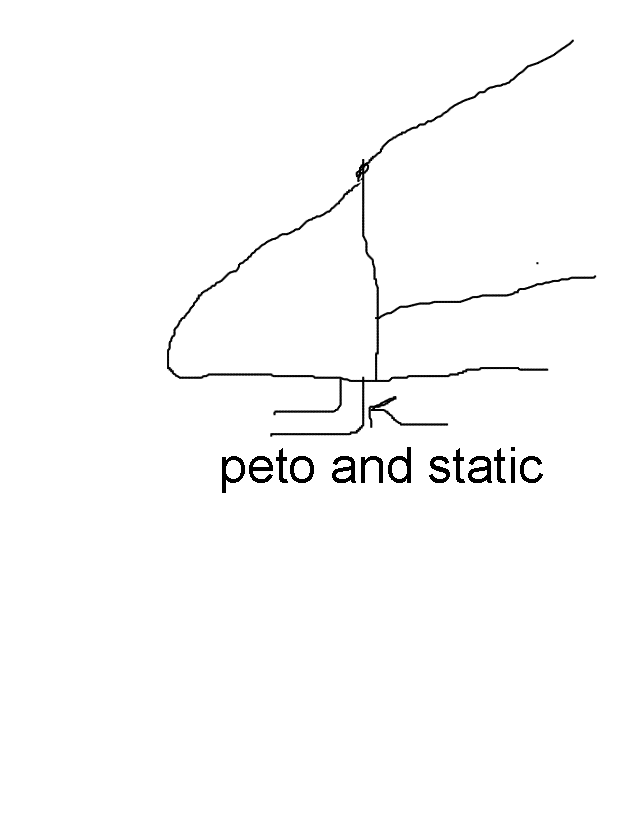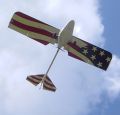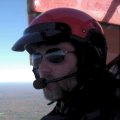 |
Matronics Email Lists
Web Forum Interface to the Matronics Email Lists
|
| View previous topic :: View next topic |
| Author |
Message |
mdnanwelch7(at)hotmail.co
Guest
|
 Posted: Sat Jan 15, 2011 11:28 am Post subject: Pitot static port location Posted: Sat Jan 15, 2011 11:28 am Post subject: Pitot static port location |
 |
|
Guys,
I'm VERY close to being able to permanently install my front instrument panel/console. I have already installed the overhead panel. Next will be the task of hooking up the various sending units, loose wires, etc., the stuff you can't do until the panel gets installed into the plane. As far as all the wires between the two panels is concerned, this is simply a matter of plugging together two DB15 plugs.
As many of you may recall, I recently installed my airspeed indicator pitot (under the front edge of the nosecone).
Yesterday, I made the static pitot fitting (for the unpressurized static source)
Here's my question; Do any of you have a recommended place on the nosecone for the static pitot fitting? Or is it okay to locate it ANYWHERE on the side of the nosecone? The inlet hole for the static air is a drilled hole about .025 dia. (It is TINY!!!!!, just slightly larger around than a pin)
Here is a second question! To make sure that the exterior fitting doesn't get either higher or lower pressure than static, would it be a good idea to drill an EXTRA hole into one of the interior static line "T's? (the static line supplies air to 3 instruments)
By drilling an extra hole into an interior T, I would be allowing for BOTH static air inside and outside of the cabin.
I know you are not supposed to rely ONLY on inside static air, because it is possible that the inside cabin MAY have slightly higher or lower static air, due to cabin design.
Anyone have some training on the pitot system, and at this point, the static part of it?
Thanks for any advice,
Mike Welch
MkIII
| | - The Matronics Kolb-List Email Forum - | | | Use the List Feature Navigator to browse the many List utilities available such as the Email Subscriptions page, Archive Search & Download, 7-Day Browse, Chat, FAQ, Photoshare, and much more:
http://www.matronics.com/Navigator?Kolb-List |
|
|
|
| Back to top |
|
 |
John Hauck

Joined: 09 Jan 2006
Posts: 4639
Location: Titus, Alabama (hauck's holler)
|
 Posted: Sat Jan 15, 2011 11:50 am Post subject: Pitot static port location Posted: Sat Jan 15, 2011 11:50 am Post subject: Pitot static port location |
 |
|
Anyone have some training on the pitot system, and at this point, the
static part of it?
Thanks for any advice,
Mike Welch
Mike W/Gang:
I have no training on the the pitot/static system, only practical experience
that works for me.
If I was going to use a system similar to yours, I would use a static port
on each side of the nose cone, combine these two ports into a T fitting,
then into your instruments. By doing this, you eliminate the pressurization
or vacuum of a single port when the aircraft is not quite in yaw trim, one
side or the other.
Once flying, the static ports can be calibrated by taking a tiny bit of
material off the aft side of each static port, if they are pressurizing, or
off the forward side of the hole if it is creating a vacuum.
The reason I settled on this system for my Firestar is because I tried it
single first, then found it to be a more workable solution with two ports.
BTW: I used 1/16" ID ports.
john h
mkIII
hauck's holler
Titus, Alabama
| | - The Matronics Kolb-List Email Forum - | | | Use the List Feature Navigator to browse the many List utilities available such as the Email Subscriptions page, Archive Search & Download, 7-Day Browse, Chat, FAQ, Photoshare, and much more:
http://www.matronics.com/Navigator?Kolb-List |
|
_________________
John Hauck
MKIII/912ULS
hauck's holler
Titus, Alabama |
|
| Back to top |
|
 |
mdnanwelch7(at)hotmail.co
Guest
|
 Posted: Sat Jan 15, 2011 12:42 pm Post subject: Pitot static port location Posted: Sat Jan 15, 2011 12:42 pm Post subject: Pitot static port location |
 |
|
| Quote: | If I was going to use a system similar to yours, I would use a static port
on each side of the nose cone, combine these two ports into a T fitting,
then into your instruments. By doing this, you eliminate the pressurization
or vacuum of a single port when the aircraft is not quite in yaw trim, one
side or the other.
Once flying, the static ports can be calibrated by taking a tiny bit of
material off the aft side of each static port, if they are pressurizing, or
off the forward side of the hole if it is creating a vacuum.
The reason I settled on this system for my Firestar is because I tried it
single first, then found it to be a more workable solution with two ports.
BTW: I used 1/16" ID ports.
john h
mkIII
hauck's holler
Titus, Alabama
|
John,
I clearly see the logic in the "each side" of the fuselage idea. It seems as
though if one side were being slightly pressurized, for the most part, the opposite
side would equally 'depressurized'. I need to get another 'T'.
What about the interior hole through one of the 'T's', which would include the
inside of the cabin into the static system? A small hole into one of the 'T's'
(in the static source) would then be giving you three locations of "supposedly"
unpressurized air; left side fuselage, right side fuselage, interior fuselage.
Is this unnecessary, would it help any? Opinions???
I did a quick check of A/C Spruce, and this is vitually identical to what I made, except that
my circular flat part is MUCH thinner than theirs;
http://www.aircraftspruce.com/catalog/inpages/alumstaticports.php
Also, from the looks of it in the photo, my drilled hole appears to be the exact
same size as in the photo. I'm trying to keep the inlet hole as small as possible, to
reduce any "ram air" affect. I'll do some more research on the inlet hole size.
Thanks for the pointers.....especially the 'each side of the fuselage' part.
Mike Welch
[quote][b]
| | - The Matronics Kolb-List Email Forum - | | | Use the List Feature Navigator to browse the many List utilities available such as the Email Subscriptions page, Archive Search & Download, 7-Day Browse, Chat, FAQ, Photoshare, and much more:
http://www.matronics.com/Navigator?Kolb-List |
|
|
|
| Back to top |
|
 |
by0ung(at)brigham.net
Guest
|
 Posted: Sat Jan 15, 2011 1:08 pm Post subject: Pitot static port location Posted: Sat Jan 15, 2011 1:08 pm Post subject: Pitot static port location |
 |
|
Here's my question; Do any of you have a recommended place on the nosecone for the static pitot fitting? Or is it okay to locate it ANYWHERE on the side of the nosecone? The inlet hole for the static air is a drilled hole about .025 dia. (It is TINY!!!!!, just slightly larger around than a pin)
>>>>>>>>>>>>>>
sorry about the drawing... this is what i did.
boyd young
mkiii
[img]cid:F828A39684FD4CCBB62CD87CC2EC205E(at)laptop1[/img]
| | - The Matronics Kolb-List Email Forum - | | | Use the List Feature Navigator to browse the many List utilities available such as the Email Subscriptions page, Archive Search & Download, 7-Day Browse, Chat, FAQ, Photoshare, and much more:
http://www.matronics.com/Navigator?Kolb-List |
|
| Description: |
|
| Filesize: |
516.6 KB |
| Viewed: |
6649 Time(s) |

|
|
|
| Back to top |
|
 |
mdnanwelch7(at)hotmail.co
Guest
|
 Posted: Sat Jan 15, 2011 1:44 pm Post subject: Pitot static port location Posted: Sat Jan 15, 2011 1:44 pm Post subject: Pitot static port location |
 |
|
Hi Boyd,
Thanks for the drawing, your drawing is plenty good enough
for us to get the idea of what you have.
But, I would prefer to use those flush-mount type of static ports like
I previously showed the link of; the ones that look like this;
http://www.aircraftspruce.com/catalog/inpages/alumstaticports.php
From what I've been researching, I think John has me headed in
the right direction, namely a port on each side of the fuselage.
I'm afraid that if I had a port on the underside of the Xtra nosecone
it would definitely be getting slightly pressurized air with the flush
mounted type ports.
I still not sure about the interior vent hole through one of the "T's", though.
>From what I've been reading, it may not be all that necessary,
especially if a guy went with two side ports!
I did find that a Cessna 150 uses a .040" static hole (the guy said 1mm,
which is .040") Cessna also has only one outside port, too. Some
of them have an inside port, which I guess you can open by way of a knob
or something, if you thought the outside was plugged, iced over, or whatever.
Thanks for the input, guys. I think I have enough good information to go
ahead and finish the static line installation.
Mike Welch
MkIII
[quote][b]
| | - The Matronics Kolb-List Email Forum - | | | Use the List Feature Navigator to browse the many List utilities available such as the Email Subscriptions page, Archive Search & Download, 7-Day Browse, Chat, FAQ, Photoshare, and much more:
http://www.matronics.com/Navigator?Kolb-List |
|
|
|
| Back to top |
|
 |
rickofudall

Joined: 19 Sep 2009
Posts: 1392
Location: Udall, KS, USA
|
 Posted: Sat Jan 15, 2011 3:40 pm Post subject: Pitot static port location Posted: Sat Jan 15, 2011 3:40 pm Post subject: Pitot static port location |
 |
|
Mike, I'd recommend you do either static ports or just vent them into the cockpit, not both, for the simple reason I think you'll play heck trying to tune the system if you have both.Yes, some Cessnas have an alternate static source valve with a knob on the panel to actuate it, for those that don't, student pilots are taught that should ice fowl the static ports the solution is to break the glass face of the VSI and vent the system that way.
Rick Girard
On Sat, Jan 15, 2011 at 3:41 PM, Mike Welch <mdnanwelch7(at)hotmail.com (mdnanwelch7(at)hotmail.com)> wrote:
| Quote: | Hi Boyd,
Thanks for the drawing, your drawing is plenty good enough
for us to get the idea of what you have.
But, I would prefer to use those flush-mount type of static ports like
I previously showed the link of; the ones that look like this;
http://www.aircraftspruce.com/catalog/inpages/alumstaticports.php
From what I've been researching, I think John has me headed in
the right direction, namely a port on each side of the fuselage.
I'm afraid that if I had a port on the underside of the Xtra nosecone
it would definitely be getting slightly pressurized air with the flush
mounted type ports.
I still not sure about the interior vent hole through one of the "T's", though.
>From what I've been reading, it may not be all that necessary,
especially if a guy went with two side ports!
I did find that a Cessna 150 uses a .040" static hole (the guy said 1mm,
which is .040") Cessna also has only one outside port, too. Some
of them have an inside port, which I guess you can open by way of a knob
or something, if you thought the outside was plugged, iced over, or whatever.
Thanks for the input, guys. I think I have enough good information to go
ahead and finish the static line installation.
Mike Welch
MkIII
| Quote: |
get="_blank">http://www.matronics.com/Navigator?Kolb-List
tp://forums.matronics.com
_blank">http://www.matronics.com/contribution
|
|
--
Zulu Delta
Kolb Mk IIIC
582 Gray head
4.00 C gearbox
3 blade WD
Thanks, Homer GBYM
It is not bigotry to be certain we are right; but it is bigotry to be unable to imagine how we might possibly have gone wrong.
- G.K. Chesterton
[quote][b]
| | - The Matronics Kolb-List Email Forum - | | | Use the List Feature Navigator to browse the many List utilities available such as the Email Subscriptions page, Archive Search & Download, 7-Day Browse, Chat, FAQ, Photoshare, and much more:
http://www.matronics.com/Navigator?Kolb-List |
|
_________________
The smallest miracle right in front of you is enough to make you happy.... |
|
| Back to top |
|
 |
mdnanwelch7(at)hotmail.co
Guest
|
 Posted: Sat Jan 15, 2011 6:46 pm Post subject: Pitot static port location Posted: Sat Jan 15, 2011 6:46 pm Post subject: Pitot static port location |
 |
|
>Mike, I'd recommend you do either static ports or just vent them into the cockpit, not both, for the simple reason I think you'll play heck >trying to tune the system if you have both.
>>Rick Girard
Hi Rick,
I'd say at this point I agree with you and John, I ought to go with just the
two side ports.
I'm just thinking out-loud here........
At the risk of over-thinking this I was just wondering, since the main
objective of the 'static' source is simply that, "static" , what we want is
absolutely uncharged, unpressurized air. I definitely see the logic in John's
suggestion of the two side ports, but just the fact that the air is rushing past
a nosecone has GOT to have some kind of slight pressurization, whether it
be positive or negative, however slight it may be.
When I try to wrap my mind around the objective of getting an "ambient"
static air source, I can't picture how having both (two side port fittings and
an inside hole in a fitting 'T') would do anything but create an even better
balance to having zero pressure.
I'm not arguing with you, I just don't see it intuitively. You might be absolutely
correct.
It was my intention all along to try out the whole airspeed indicator(s) system
in the car. Since my entire panel is somewhat portable at this point, and I do have
the entire pitot system 100% built, hoses, tubes, fittings and all, I could set the
entire arrangement on the seat of my truck, and go buzzing down the highway.
I could try a couple of pitot designs and try to get a feel for what might work best in
my situation.
I think the thing I'm trying to get a good handle on is if the airspeed indicator is
going to be 'reasonably' accurate on my first time out. I don't expect it to be
gnat's ass perfect, but then I'd rather it wasn't off by 25 mph, either. Maybe taking
it for a spin down the highway will give me a little indication of it's approximate
accuracy.
(BTW, I do realize that when flight testing the plane, the important point is
to know what the airspeed indicator says for certain flight functions (like stall
speed, for instance), and learn those readings, regardless of how accurate they
are. In other words, if the ASI says stall happens at 37 mph, then never try to
fly less than 37 mph.....period!!!
Hey, thanks for the help, guys. I'm going to try to get some 'down the highway'
readings. I'll let you know what I come up with. I also include various static
pitot source designs. More later.......
Mike Welch
[quote][b]
| | - The Matronics Kolb-List Email Forum - | | | Use the List Feature Navigator to browse the many List utilities available such as the Email Subscriptions page, Archive Search & Download, 7-Day Browse, Chat, FAQ, Photoshare, and much more:
http://www.matronics.com/Navigator?Kolb-List |
|
|
|
| Back to top |
|
 |
John Hauck

Joined: 09 Jan 2006
Posts: 4639
Location: Titus, Alabama (hauck's holler)
|
 Posted: Sat Jan 15, 2011 7:05 pm Post subject: Pitot static port location Posted: Sat Jan 15, 2011 7:05 pm Post subject: Pitot static port location |
 |
|
When I try to wrap my mind around the objective of getting an "ambient"
static air source, I can't picture how having both (two side port fittings
and
an inside hole in a fitting 'T') would do anything but create an even better
balance to having zero pressure.
Mike Welch
Mike W/Gang:
That is why I said you can fine tune the static ports after you fly the
airplane by taking a little material off the fore or aft side of the port,
depending on whether the ASI is reading high or low, pressure or vacuum.
There are also other ways to fine tune the static system. Use your
imagination.
You are looking for one static source that will read the same air pressure
as the pitot tube is flying in.
Testing your ASI in your truck will do nothing for the installation in your
airplane.
If you take a static source inside the cockpit of a MKIII or FS, it will be
low pressure. It is the nature of the nose pod flying through the air.
What I shared with you is a proven system that worked well for me.
john h
mkIII
hauck's holler
Titus, Alabama
| | - The Matronics Kolb-List Email Forum - | | | Use the List Feature Navigator to browse the many List utilities available such as the Email Subscriptions page, Archive Search & Download, 7-Day Browse, Chat, FAQ, Photoshare, and much more:
http://www.matronics.com/Navigator?Kolb-List |
|
_________________
John Hauck
MKIII/912ULS
hauck's holler
Titus, Alabama |
|
| Back to top |
|
 |
gpabruce(at)gmail.com
Guest
|
 Posted: Sat Jan 15, 2011 7:49 pm Post subject: Pitot static port location Posted: Sat Jan 15, 2011 7:49 pm Post subject: Pitot static port location |
 |
|
Nice drawing of a vulture with whiskers . . . just kidding . . .
On Sat, Jan 15, 2011 at 1:05 PM, b young <by0ung(at)brigham.net (by0ung(at)brigham.net)> wrote:
[quote]
Here's my question; Do any of you have a recommended place on the nosecone for the static pitot fitting? Or is it okay to locate it ANYWHERE on the side of the nosecone? The inlet hole for the static air is a drilled hole about .025 dia. (It is TINY!!!!!, just slightly larger around than a pin)
>>>>>>>>>>>>>>
sorry about the drawing... this is what i did.
boyd young
mkiii
[img]https://mail.google.com/mail/html/compose/static_files/blank_quirks.html?ui=2&ik=1f31465df0&view=att&th=12d8b8bd3bc78d96&attid=0.1&disp=emb&zw[/img]
[b]
| | - The Matronics Kolb-List Email Forum - | | | Use the List Feature Navigator to browse the many List utilities available such as the Email Subscriptions page, Archive Search & Download, 7-Day Browse, Chat, FAQ, Photoshare, and much more:
http://www.matronics.com/Navigator?Kolb-List |
|
|
|
| Back to top |
|
 |
mdnanwelch7(at)hotmail.co
Guest
|
 Posted: Sat Jan 15, 2011 9:06 pm Post subject: Pitot static port location Posted: Sat Jan 15, 2011 9:06 pm Post subject: Pitot static port location |
 |
|
John,
Okay!! I got the message! I'll proceed as you suggested.
Two side ports, 1/16" fitting holes, adjust as needed. Got it.
Thanks,
Mike W
[quote][b]
| | - The Matronics Kolb-List Email Forum - | | | Use the List Feature Navigator to browse the many List utilities available such as the Email Subscriptions page, Archive Search & Download, 7-Day Browse, Chat, FAQ, Photoshare, and much more:
http://www.matronics.com/Navigator?Kolb-List |
|
|
|
| Back to top |
|
 |
kuffel(at)cyberport.net
Guest
|
 Posted: Sun Jan 16, 2011 1:49 am Post subject: Pitot static port location Posted: Sun Jan 16, 2011 1:49 am Post subject: Pitot static port location |
 |
|
Mike,
Strongly endorse Hauck's suggestions for a static system of two side ports
connected by a T. It has been a well proven industry standard for many
years.
To expand slightly:
Put the ports as far aft on the nose cone as reasonable. You want the air
at the port to be going parallel to the surface, not accelerating around a
curve.
<< Once flying, the static ports can be calibrated by taking a tiny bit of
material off the aft side of each static port, if they are pressurizing, or
off the forward side of the hole if it is creating a vacuum. >>
There is a simpler way of determining which way to trim the ports than
airspeed error. Go to a long, level runway and make a takeoff keeping the
aircraft planted on the runway as long as possible. Just before liftoff
note any change in *altitude*. If the altimeter goes up you have a vacuum,
if it goes down you have static pressurization. This maneuver does take
some practice and should be repeated several times to be sure of correct
indication.
Instead of removing material you can add wedges on the other side: front
side if static is high, back side if static is low. You can also buy static
ports with a wedge built in. Much more professional looking than balsa
wedges glued on. These you rotate to get most accurate readings.
Tom Kuffel
| | - The Matronics Kolb-List Email Forum - | | | Use the List Feature Navigator to browse the many List utilities available such as the Email Subscriptions page, Archive Search & Download, 7-Day Browse, Chat, FAQ, Photoshare, and much more:
http://www.matronics.com/Navigator?Kolb-List |
|
|
|
| Back to top |
|
 |
Richard Pike

Joined: 09 Jan 2006
Posts: 1671
Location: Blountville, Tennessee
|
 Posted: Sun Jan 16, 2011 6:00 am Post subject: Re: Pitot static port location Posted: Sun Jan 16, 2011 6:00 am Post subject: Re: Pitot static port location |
 |
|
Boyd's drawing looks like what I am using. One is the pitot, the other is static port, both are out away from the airframe in clean air, seems to make life simpler. Worked right the first time, needed no tuning. Your results may vary...
Details here:
http://www.bcchapel.org/pages/0003/pg7.htm
Richard Pike
MKIII N420P (420ldPoops)
| | - The Matronics Kolb-List Email Forum - | | | Use the List Feature Navigator to browse the many List utilities available such as the Email Subscriptions page, Archive Search & Download, 7-Day Browse, Chat, FAQ, Photoshare, and much more:
http://www.matronics.com/Navigator?Kolb-List |
|
|
|
| Back to top |
|
 |
mdnanwelch7(at)hotmail.co
Guest
|
 Posted: Sun Jan 16, 2011 6:39 am Post subject: Pitot static port location Posted: Sun Jan 16, 2011 6:39 am Post subject: Pitot static port location |
 |
|
> Boyd's drawing looks like what I am using.
| Quote: | Richard Pike
MKIII N420P (420ldPoops)
|
Bro. Richard,
Although I do agree Boyd's and your suggestion of the static inlet
works well out on an extended tube, I would prefer to go with the
type of fitting that mounts on the surface of the fuselage. But, thanks
for your input!!
At this point, I concede I know when I'm given good advice. John H
was generous enough to offer what says worked well for him. Although
I did agree, I was curious if a slight (unnecessary) modification would be
better. He, Rick G, and Ted K didn't think so!! (probably others, too)
That's good enough for me!!
I appreciate everyone's input, and value the advice I have been given.
I think I'll go with the two, side fuselage, surface mount ports, no inside
cabin venting, and 1/16" vent holes.
Thanks, guys.
Mike Welch
[quote][b]
| | - The Matronics Kolb-List Email Forum - | | | Use the List Feature Navigator to browse the many List utilities available such as the Email Subscriptions page, Archive Search & Download, 7-Day Browse, Chat, FAQ, Photoshare, and much more:
http://www.matronics.com/Navigator?Kolb-List |
|
|
|
| Back to top |
|
 |
Dana

Joined: 13 Dec 2007
Posts: 1047
Location: Connecticut, USA
|
 Posted: Sun Jan 16, 2011 5:51 pm Post subject: Pitot static port location Posted: Sun Jan 16, 2011 5:51 pm Post subject: Pitot static port location |
 |
|
Mike,
I'm coming into this discussion late, sounds like you already have a plan, but I'll add my two cents:
Putting ports on both sides helps to cancel out any variation as the aircraft yaws. On the bottom wouldn't be good as it'd change as AOA changes. Inside the cockpit is a bad place because the air inside is nearly always _not_ at static pressure.
I built a concentric pitot/static tube, with the inner tube for the pitot and the outer one (sealed at front and back) with four holes spaced around the center for static air. Mounted on the nose such a system will give very good undisturbed static air.
-Dana
--
Congress shall make no law....What part of NO didn't you understand?
[quote][b]
| | - The Matronics Kolb-List Email Forum - | | | Use the List Feature Navigator to browse the many List utilities available such as the Email Subscriptions page, Archive Search & Download, 7-Day Browse, Chat, FAQ, Photoshare, and much more:
http://www.matronics.com/Navigator?Kolb-List |
|
|
|
| Back to top |
|
 |
Thom Riddle

Joined: 10 Jan 2006
Posts: 1597
Location: Buffalo, NY, USA (9G0)
|
 Posted: Mon Jan 17, 2011 5:12 am Post subject: Re: Pitot static port location Posted: Mon Jan 17, 2011 5:12 am Post subject: Re: Pitot static port location |
 |
|
I have had good success in changing the pressure seen by the static ports using a dab of RTV either fore or aft of the port.
My current Slingshot setup has the dual pitot/static tubes mounted below the nose cone with an extender for the pitot mounted flexibly and going out about six inches forward of the nose. My static tube has a Tee in side the cockpit so it is sensing both the pressure outside the at the static port and under the panel. With this setup, it reads TAS on the ASI at about 2,000' - 2,500' density altitude.
Speaking of density altitude, I calculated it this morning and here at KBUF, the DA at 7 AM was negative(-)3,675'. Coldest yet this winter here at 1 degree.... but clear skies for a change and low winds. About -4F at my house.
| | - The Matronics Kolb-List Email Forum - | | | Use the List Feature Navigator to browse the many List utilities available such as the Email Subscriptions page, Archive Search & Download, 7-Day Browse, Chat, FAQ, Photoshare, and much more:
http://www.matronics.com/Navigator?Kolb-List |
|
_________________
Thom Riddle
Buffalo, NY (9G0)
Don't worry about old age... it doesn't last very long.
- Anonymous |
|
| Back to top |
|
 |
mdnanwelch7(at)hotmail.co
Guest
|
 Posted: Mon Jan 17, 2011 6:22 am Post subject: Pitot static port location Posted: Mon Jan 17, 2011 6:22 am Post subject: Pitot static port location |
 |
|
> Speaking of density altitude, I calculated it this morning and here at KBUF, the DA at 7 AM was -3,675'. >
| Quote: | --------
Thom Riddle
Buffalo, NY (9G0)
Kolb Slingshot SS-021
Jabiru 2200A #1574
Tennessee Prop 64x32
|
Hi Thom,
Thanks for the pitot info.
-3,675' density altitude?? I think even Capt Nemo would have trouble flying
at that level!! (think about it, it'll come to you)
BTW, thanks for the pitot comments, everyone, but I think I'll proceed with
what I mentioned previously (2 side ports, etc, etc.) If that design needs some adjustment,
then I'll work on it later. Cheers!!
Mike Welch
[quote][b]
| | - The Matronics Kolb-List Email Forum - | | | Use the List Feature Navigator to browse the many List utilities available such as the Email Subscriptions page, Archive Search & Download, 7-Day Browse, Chat, FAQ, Photoshare, and much more:
http://www.matronics.com/Navigator?Kolb-List |
|
|
|
| Back to top |
|
 |
|
|
You cannot post new topics in this forum
You cannot reply to topics in this forum
You cannot edit your posts in this forum
You cannot delete your posts in this forum
You cannot vote in polls in this forum
You cannot attach files in this forum
You can download files in this forum
|
Powered by phpBB © 2001, 2005 phpBB Group
|



